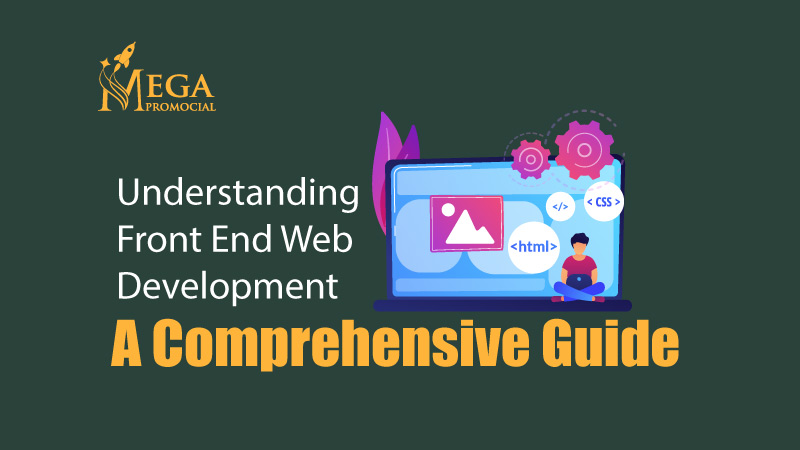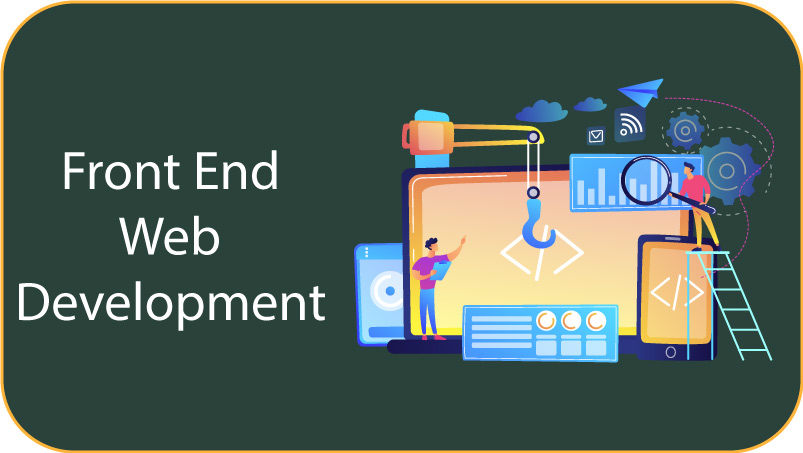Navigating the Future: Key Industry Trends Shaping Digital Marketing
In the fast-paced world of digital marketing, staying ahead of the curve is essential for businesses and marketer

Introduction:
Entering the realm of web development, the term “front end” is likely to surface frequently. In essence, front end web development refers to the art and practice of crafting the visual and interactive elements of a website or web application. This spans from the overall layout and design down to the individual buttons and forms that users encounter during their online journey.

Front end development holds paramount importance as it dictates the user experience. Serving as the portal for visitors, it molds their initial impressions and guides their interaction with a site. A seamlessly designed front end not only captivates users but ensures a user-friendly and intuitive experience, contributing significantly to overall satisfaction.
Distinguishing itself from other facets of web development, front end exclusively focuses on the user interface (UI) and user experience (UX). While back-end development manages server-side operations and databases, and full-stack development involves both front and back end, front end developers specialize in the aesthetic and interactive components users directly engage with.
Now, let’s delve into the captivating world of front-end web development, exploring its intricacies and understanding how it sets itself apart. From responsive layouts that adapt to various devices to intuitive navigation facilitated by strategically placed buttons and forms, front end developers meticulously craft digital landscapes to enhance user engagement.
The Fundamental Concept of Front-End Development:
In web development, the front end is the user’s interface, encompassing the design and interactivity of a website. Front-end developers craft layouts, buttons, forms, and other elements that users directly interact with, employing design principles like color theory and typography. Front end development is the art of shaping the user interface for enhanced usability and aesthetics. HTML structures information, CSS adds style, and JavaScript injects functionality, creating a harmonious blend that brings designs to life. This collaborative use of HTML, CSS, and JavaScript is fundamental to delivering a seamless and visually appealing user experience on the web.
Key Elements of Front-End Development
Role of a Front-End Developer
Front-end developers serve as the architects of the digital realm, transforming static designs into dynamic and functional websites. Their pivotal role involves breathing life into visual concepts, bridging the gap between aesthetics and functionality. Operating in tandem with designers and back-end developers, front-end developers bring a holistic approach to web development, ensuring a seamless fusion of design brilliance and technical prowess.
At the heart of their skill set lies proficiency in HTML, the structural backbone that defines a webpage’s content and layout. Complementing this, CSS enables front-end developers to apply styles and formatting, transforming raw HTML into visually stunning and cohesive designs. Leveraging JavaScript, a dynamic scripting language, empowers them to infuse interactivity, creating responsive and engaging user interfaces.
Collaboration is key in front-end development, necessitating effective communication with designers to translate visual concepts into code. Working harmoniously with back-end counterparts, front-end developers integrate server-side functionalities to ensure a cohesive user experience. Proficient in user-centric design and UX principles, they prioritize intuitive navigation and overall usability.
Front-end developers are the architects adept at translating design visions into tangible, functional code. Their unique ability to harmonize aesthetics with technical implementation defines the success of digital products, positioning them as integral contributors to the ever-evolving landscape of web development.
Importance of Front-End Development
Front-end development serves as the foundation for user interactions on websites and applications, playing a pivotal role in shaping user impressions. A well-crafted and user-friendly interface is essential for capturing attention, fostering engagement, and boosting conversion rates. When users encounter an aesthetically pleasing and intuitively designed interface, it establishes a positive first impression and encourages them to explore further.
Optimized front-end code is integral to delivering a seamless user experience. Fast loading times, facilitated by efficient code, contribute significantly to user satisfaction. In today’s fast-paced digital landscape, users expect instant access to information, and a swift-loading website enhances overall usability. Smooth transitions and responsive design further enhance the user experience, ensuring that interactions feel natural and effortless across various devices and screen sizes.
Accessibility is a paramount consideration in front-end development. A user-friendly interface should be inclusive, catering to individuals with diverse needs and abilities. Adhering to accessibility standards like WCAG in front-end development ensures websites are usable by everyone, including those with disabilities. Creating an accessible interface aligns with ethical principles, complies with legal requirements, prevents potential lawsuits, and expands the website’s reach to a wider audience, promoting inclusivity in the digital space.
Learning Front End Development
If you’re eager to venture into front-end development, now is the opportune moment given the surging demand for skilled developers. A robust foundation in HTML, CSS, and JavaScript is pivotal, as these form the core technologies driving visually appealing and interactive websites.
Explore online tutorials and courses on platforms like Codecademy, FreeCodeCamp, and Udemy, offering tailored content for beginners and advanced learners. These resources provide structured guidance, hands-on exercises, and real-world projects for practical experience.
Supplement your learning with books, blogs, and YouTube channels dedicated to front-end development, offering insights and tips from seasoned developers. Practice is key, so embark on small projects, gradually progressing to more complex endeavors. Building personal websites or simple web applications will solidify your understanding and enhance your skills.
Networking is invaluable; connect with fellow front-end developers and engage in online communities to glean knowledge and support. Engage in discussions, ask questions, and seek feedback to accelerate your front-end development learning. Stay informed about the latest trends and technologies. With active participation, you’ll swiftly advance on your journey and master the dynamic field of front-end development.
Emerging Trends in Front End Development:
Front-end development is dynamic and ever-evolving, characterized by ongoing trends shaping the design and development landscape. Staying updated on these trends is crucial for developers and designers striving to create cutting-edge, user-centric interfaces. The field is currently influenced by several noteworthy trends that shape the front-end development space.
Responsive design frameworks have become a cornerstone in front-end development. With the proliferation of diverse devices and screen sizes, frameworks like Bootstrap and Tailwind CSS provide developers with tools to create interfaces that adapt seamlessly to various platforms, ensuring a consistent and optimized user experience.
Progressive Web Apps (PWAs) represent another influential trend. These applications combine the best of web and mobile experiences, offering features like offline access, push notifications, and fast loading times. PWAs enhance user engagement and satisfaction by providing app-like experiences without the need for installation. Animation and micro interactions are gaining prominence in front-end development to enhance user engagement and create more dynamic interfaces. Thoughtful animations and subtle interactions contribute to a more immersive user experience, making the interface visually appealing and interactive.
Static site generators have become popular for their efficiency and speed in generating static HTML pages. This trend simplifies the development process, improves site performance, and facilitates easier maintenance, making static site generators a preferred choice for various projects.
Voice user interfaces (VUIs) are emerging as a significant trend with the rise of voice-activated devices. Integrating voice commands into interfaces requires specialized development techniques, offering users a hands-free and convenient way to interact with applications and websites.
Artificial Intelligence (AI) integration is transforming front-end development by enabling personalized and predictive user experiences. AI-driven features such as chatbots, recommendation engines, and smart content filtering enhance user engagement by delivering tailored and contextually relevant content.
Tools for Front End Development
In a front-end developer’s arsenal, a diverse set of tools streamlines development, enhances efficiency, and ensures high-quality, responsive interfaces. These tools are crucial for facilitating code management, implementing design, debugging, and optimization processes, collectively contributing to the creation of effective and visually appealing web applications. Here are some essential tools found in a front-end developer’s toolkit:
Front End Frameworks
Front-end frameworks stand as indispensable assets in the toolkit of front-end developers, serving as accelerators for development while elevating the functionality and aesthetics of websites and web applications. These frameworks furnish a curated assortment of pre-built, reusable components and libraries, introducing a structured approach to front-end development that empowers developers to concentrate on crafting distinctive designs and implementing bespoke features.
One preeminent front-end framework is Bootstrap, celebrated for its responsive grid system that expedites the creation of mobile-friendly websites. Beyond this, Bootstrap boasts a diverse array of pre-designed components—ranging from buttons to forms and navigation menus—each effortlessly customizable to harmonize with the envisioned look and feel of a website. Recognized for its hallmark simplicity and adaptability, Bootstrap caters to both novice and seasoned developers, becoming a stalwart choice in the development landscape.
In the realm of JavaScript libraries, react emerges as a frontrunner, concentrating on constructing user interfaces, particularly for single-page applications. Its architectural cornerstone lies in a component-based structure, enabling developers to forge reusable UI components, thereby streamlining maintenance and updates. React’s prowess extends to efficient rendering and state management, culminating in swift and responsive user interfaces that resonate with developers, solidifying its position in the front-end development ecosystem.
Angular, another commanding front-end framework, finds prominence in the construction of large-scale applications. Offering a robust framework for dynamic web applications, Angular integrates features such as two-way data binding, dependency injection, and a potent templating system. Augmented by a comprehensive suite of tools for testing, debugging, and scalable application development, Angular emerges as a go-to choose for developers navigating the complexities of expansive projects.
In the dynamic landscape of front-end development, these frameworks serve as catalysts, propelling developers towards innovative design and custom feature implementation. Bootstrap for its simplicity, React for UI-centric applications, and Angular for the challenges of large-scale endeavors—each framework stands as a testament to the versatility and indispensability of front-end development tools.
Front End Optimization Tips
Optimizing front-end performance is crucial for delivering a fast, responsive, and user-friendly web experience. This involves employing a variety of techniques to enhance loading times, reduce latency, and improve overall site performance.
Best Practices for Front End Development

Following best practices in front-end development is essential for crafting high-quality, efficient code and delivering exceptional digital experiences. These practices encompass a combination of organizational, technical, and user-centric considerations:
In conclusion, front-end development is a captivating blend of art and science, where creativity meets functionality to shape compelling digital experiences. Following best practices, including maintaining a clean codebase, optimizing performance, testing across devices, embracing responsive design, and adhering to accessibility guidelines, is essential for delivering high-quality user experiences. The role of a front-end developer as a digital artist, translating design concepts into functional interfaces, underscores the importance of proficiency in HTML, CSS, and JavaScript.
The continuous evolution of front-end development, marked by emerging trends and tools, emphasizes the need for developers to stay updated and adaptable. Version control systems and collaboration with design and back-end development teams play a crucial role in ensuring the seamless integration of aesthetics and technical implementation.
As newcomers embark on their front-end development journey, acquiring a solid foundation in HTML, CSS, and JavaScript through online platforms and practical projects accelerates the learning process. Front-end developers, as architects of the digital world, play a pivotal role in shaping the user interface and influencing user satisfaction. The dynamic landscape of front-end development requires a commitment to continuous improvement, ensuring developers remain equipped to create modern, responsive, and visually appealing web applications that resonate with users. Welcome to the world of front-end web development, where innovation and user-centric design converge to shape the digital landscapes of tomorrow.
Our blog is a hub for valuable resources, informative guides, and insightful commentary on a
variety of industry topics, designed to help you stay up-to-date and informed.
In the fast-paced world of digital marketing, staying ahead of the curve is essential for businesses and marketer
In the fast-paced and ever-evolving world of digital marketing, staying informed and continuously learning is cru
In the ever-evolving world of digital marketing, staying ahead of the curve and building a strong online presence